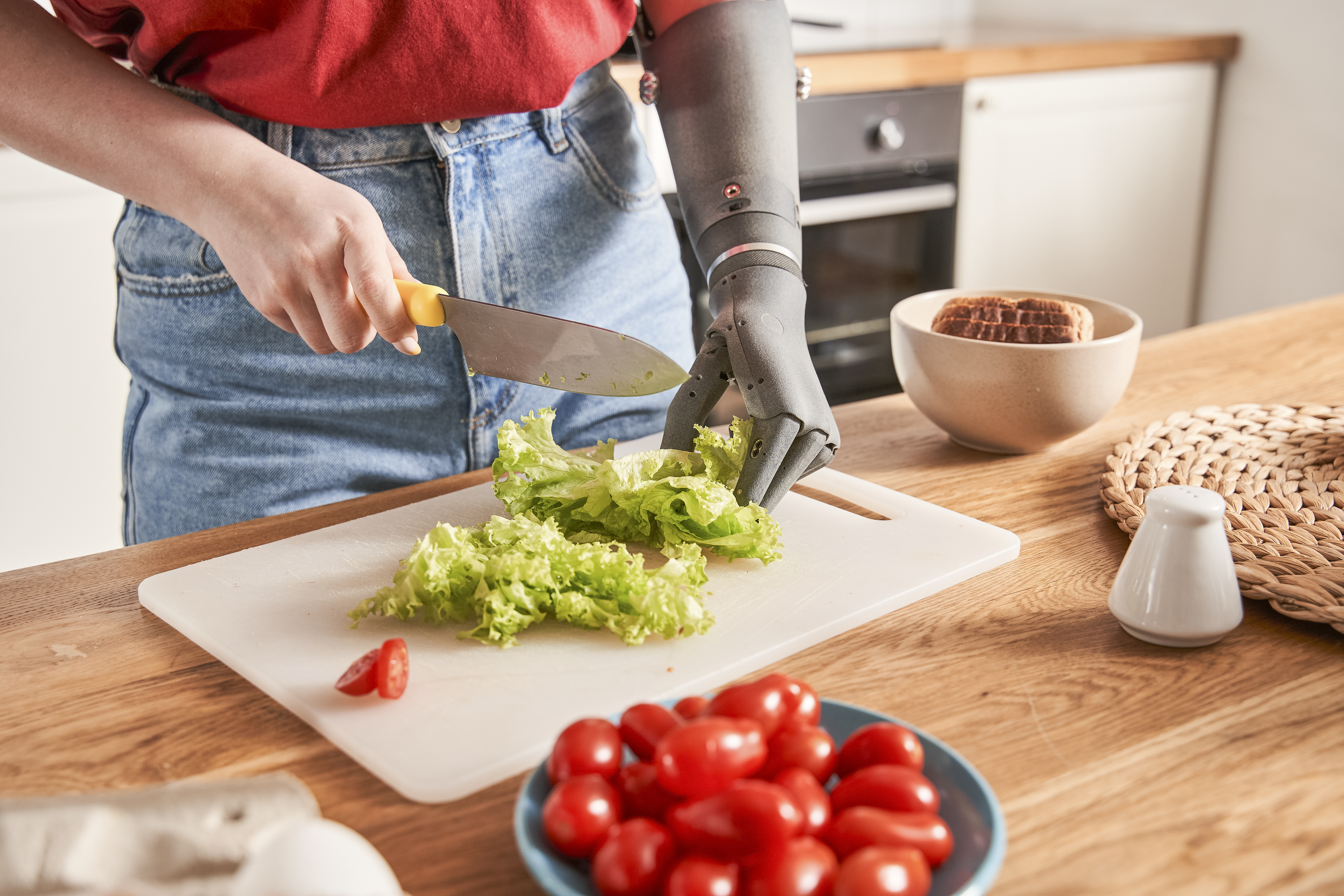Stroke survivors, people with hemiplegia, and people with limb loss or limited dexterity may experience have difficulty preparing healthy meals independently. When prepping and cooking with one hand, there are many tips and tools that can make the experience easier and safer to prevent burns and other injuries. These universal tips will promote independence and worry-free cooking for anybody wanting to sharpen their culinary skills in the kitchen.

Cutting and Chopping
• Use a food processor, a hand chopper, or a vegetable chopper to quickly chop food.
• Use a rocker knife to cut through foods rather than saw.
• A pizza cutter can also easily be used to cut quesadillas, sandwiches, and other flat foods.
• Use scissors (or one-handed scissors) to cut open packages easily.
• Utilize cutting boards that have suction cups on the bottom to prevent them from slipping. Cutting boards that also have prongs or pricks help hold produce and other food items in place to make them easier to cut.
Measuring
• Most vegetable choppers also have measurements written on the base; this allows for easy measuring without having to use measuring cups.
• Use a turkey baster to measure smaller amounts.
• Add a rubber band to open cans and containers for level measuring with dry measuring cups and spoons for flour, sugar, and other powdery ingredients.
Handling Hot Items
• With an oven mitt, pull the oven rack out slightly to make it easier to grab the dish or pan and avoid reaching deep into the oven.
• Rather than putting all ingredients on one large sheet pan, use smaller sheet pans to lighten the load when retrieving food from the oven.
• Plastic mixing bowls with a non-slip bottom are usually lighter than glass or metal bowls, making them easier to carry and a sturdy choice when stirring.
• If the microwave is placed on the counter and the food dish is heavy, slide the hot item directly onto the counter. If the microwave is built into the wall and the food dish is heavy, slide the hot item onto another nearby high surface to cool or ask someone for assistance.
• Use high quality oven mitts to prevent burns or heat exposure. Non-slip oven mitts will ensure a good grip.
• Use pots with attached strainers and have a single handle to help with straining noodles and removing excess water from steaming vegetables.
Storage
• Store food in containers that are easy to open with no twisting or hand strength required. Some lids have pull tabs while others may have buttons to poke and open the lid.
Adapted Tools
• Add handles to utensils with texture or a “build up” handle will allow for more control and strength as these make utensils easier to grasp. Add an universal cuff to a utensil to extra support.
• Use shelf lining under any bowls, plates, or cutting boards to make them nonslip.
• Scooper suction cup plates (lipped plates) can provide an immovable plate with higher lips that allow you to scoop your food onto your utensil with ease.
• A pot stabilizer helps to keep a pot in place and not move on the stove eye when using a flat top stove.
• Robo Twist is an electric jar opener that will grasp, and twist open a lid on a jar, without having to hold or barely having to hold the jar.
• A silicone food pod cooking basket allows food, like eggs, vegetables, or pasts, to be cooked in a pot and then be strained easily. Being made of silicone, it doesn’t get too hot, and they usually have an easy-to-use handle.
• Electric salt and pepper grinders make it easy to have freshly ground pepper or salt by the push of a button.
• Use a mounted opener that is nailed to a wall or hard surface to open jars and cans.
Other Considerations
• Purchase ingredients that are already measured or pre-cut to make the prepping process smoother.
• Tools with suction cups keep the object in place and are easier to use.
• To easily wash fruits and vegetables, place them in a strainer in your sink and rinse them with water until they are clean. Another way to wash fruits and vegetables is to put a scrub brush with a suction cup on the side of your sink and scrub the produce against it.
• An electric mixer can easily shred chicken after it has been cooked.
• Clamp-On vegetable peelers clamp onto the counter and make peeling vegetables an easy task while staying put.
• Crack an egg with one hand by hitting the side of the egg onto the counter or edge of a bowl. Then, pull the top part of the egg with your thumb and index finger away from the bottom part with your pinky and ring finger. This technique is difficult to complete at first, but practice will make it much easier!
• Use tongs to assist with serving items like salad or pasta or flipping things in a pan like tortillas or meat.
• Consider making extra servings of a meal and freeze it for later.
Check out NCHPAD’s Adapted Kitchen Tools, Utensils, and Accessibility resource for additional ideas to make your kitchen accessible.
Additional Resources:
• https://www.stroke.org/
• https://www.amputee-coalition.org/resources/amputee-educational-video-series/cooking-tips-for-upper-limb-amputees/
• https://chasa.org/
